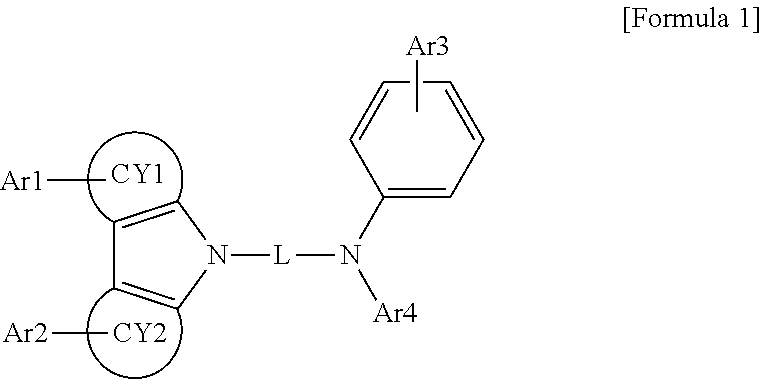Organic light emitting diode
a light-emitting diode and organic technology, applied in semiconductor devices, photovoltaic energy generation, solid-state devices, etc., can solve the problems of insufficient development of stable and efficient organic material layer materials for organic light-emitting diodes, difficult to use npb in organic light-emitting diodes requiring high current, and difficult to manufacture organic light-emitting diodes with high efficiency and a long life span. , to achieve the effect o
- Summary
- Abstract
- Description
- Claims
- Application Information
AI Technical Summary
Benefits of technology
Problems solved by technology
Method used
Image
Examples
example
Manufacturing of the Organic Light Emitting Diode
[0077]The glass substrate (corning 7059 glass) on which the thin film of ITO (indium tin oxide) was applied to a thickness of 1,000 Å was immersed in distilled water having the detergent dissolved therein, and washed by the ultrasonic wave. In this case, the detergent as used herein was the product commercially available from Fisher Co. and the distilled water was one which had been twice filtered by using the filter commercially available from Millipore Co. ITO was washed for 30 mins, and washing with ultrasonic waves was then repeated twice for 10 mins by using distilled water. After the completion of washing with distilled water, washing with ultrasonic waves was performed by using solvents such as isopropyl alcohol, acetone, and methanol, and the resulting product was dried and transported to the plasma washing machine. Further, the substrate was dry-washed by using the oxygen plasma for 5 mins, and then transported to the vacuum...
PUM
 Login to View More
Login to View More Abstract
Description
Claims
Application Information
 Login to View More
Login to View More - R&D
- Intellectual Property
- Life Sciences
- Materials
- Tech Scout
- Unparalleled Data Quality
- Higher Quality Content
- 60% Fewer Hallucinations
Browse by: Latest US Patents, China's latest patents, Technical Efficacy Thesaurus, Application Domain, Technology Topic, Popular Technical Reports.
© 2025 PatSnap. All rights reserved.Legal|Privacy policy|Modern Slavery Act Transparency Statement|Sitemap|About US| Contact US: help@patsnap.com



